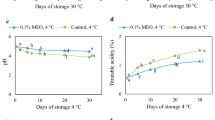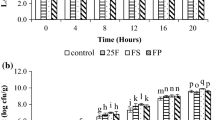Abstract
The aim of this work was to reduce the natural fermentation period of ‘idli’ from the conventional 14 h to 10 h by adding underutilized okara for the preparation of ‘idli’. Black gram was partially substituted with soy residue okara in the ratio of (1:1). After 14 h of natural fermentation, the pH and total acidity of control ‘idli’ batter was 4.51 and 0.64% and that of okara fortified ‘idli’ batter was 4.53 and 0.43%, respectively. The amount of CO2 released by the control and okara fortified batter was 19.7% and 33.6% respectively. The viable count of yeast and mold, lactics and mesophilic bacteria in control & okara batter increased with time reaching 9.00 & 10.34, 8.66 & 7.69, and 8.65 & 9.47 log10 cfu/g, respectively at the end of 10 h of natural fermentation. Okara fortified ‘idli’ was soft and spongy compared to control ‘idli’ .


Similar content being viewed by others
References
Annan NT, Plahar WA, Poll L, Jakobsen M (2005) Effect of soybean fortification on Ghanaian fermented maize dough aroma. Int J Food Sci Nutr 56(5):315–326
AOAC (1984) Official Methods of analyis 14th edn. Association of Official Analytical Chemists, Washington DC
Bharti K, Laxmi A (2008) Effect of α−amylase addition on natural fermentation of ‘idli’- A popular south Indian cereal-Legume based snack food. Lebensm Wiss Technol 41(6):1053–1059
Chan WM, Ma CY (1999) Modification of proteins from soymilk residue (okara) by trypsin. J Food Sci 64(5):781–786
Desikachar HSR, Radhakrishna Murty R, Rama Rao G, Kadkol SB (1960) Studies on ‘idli’ natural fermentation: part I-some accompanying changes in the batter. J Sci Ind Res 19C:168–172
Gobetti M, Corsetti A, Rossi J (1994) The sour dough microflora. Interactions between lactic acid bacteria and yeasts: metabolism of amino acids. World J Microbiol Biotechnol 10:275–279
Gopalan C, Rama sastri BV, Balsubranamian SC (1971) Nutritive value of Indian foods. National Institute of Nutrition, ICMR, Hyderabad
Hemalatha SP, Srinivasan K (2007) Influence of germination and natural fermentation on bioaccessibility of zinc and iron from food grains. Eur J Clin Nutr 61(3):342–348
Jama YH, Varadaraj MC (1999) Antibacterial effect of plantaricin LP84 on foodborne pathogenic bacteria occurring as contaminants during ‘idli’ batter natural fermentation. World J Microbiol Biotechnol 15:27–32
Katayama M, Wilson LA (2008) Utilization of okara, a byproduct from soymilk production, through the development of soy-Based snack Food. J Food Sci 73(3):S152
Lewis YS, Johar DS, Subrahmanyan V (1955) Studies on process simplification in the preparation of a fermented type of foodstuff—‘idli’. Central Food Technological Research Institute, Bull 4, Mysore, India, 257
Nisha P, Laxmi A, Rekha S (2005) Effect of stabilizers on stabilization of ‘idli’ (traditional south Indian food) batter during storage. Food Hydrocoll 19:179–186
Rajalakshmi R, Vanaja K (1967) Chemical and biological evolution of the effects of natural fermentation on the nutritive value of foods prepared from rice and gram. Br J Nutr 21:467–473
Ramakrishnan CV, Parekh LJ, Akolkar PN, Rao GS (1976) Studies on soy’idli’ natural fermentation. Plant Foods for Man 2:15–33
Reddy NR, Sathe SK, Pierson MD, Salunkhe DK (1982) ‘idli’, an Indian fermented food: a review. J Food Qual 5(2):89–101
Sanjeev KI, Dhanwant K (1990) Indian fermented foods: microbiological and biochemical aspects. Indian J Microbiol 30(2):135–157
Sarkar PK, Tamang JP, Cook PE, Owens JD (1994) Kinema—a traditional soybean fermented food: proximate compostion and microflora. Food Microbiol 11:47–55
Soni SK, Arora JK (2000) Indian fermented foods: Biotechnological approaches. Food processing: Biotechnological Application. Asiatech Publishers Pvt Ltd, New Delhi, p 171
Soni SK, Sandhu DK (1990) Indian fermented foods: microbiological and biochemical aspects. Indian J Microbiol 30(2):135–157
Soni SK, Sandhu DK, Vikhu KS, Karma N (1985) Studies in dosa—An indigenous Indian fermented food: some biochemistry and changes occurring during natural fermentation. Food Microbiol 3(1):45
Soni SK, Sandhu DK, Vikhu KS, Karma N (1986) Microbiological studies on dosa natural fermentation. Food Microbiol 3:45–53
Steinkraus KH, Van Veen AG, Thiebeau DB (1967) Studies on ‘idli’—An Indian fermented Black gram-rice food. Food Technol 21:916–91
Stone H, Sidel JL (1998) Quantitative descriptive analysis: developments, applications and the future. Food Technol J 52:48–52
Susheelamma NS, Rao MVL (1978) Isolation and characterization of arabino galactan from black gram (Phaseolus mungo). J Agric Food Chem 26(6):1434–1437
Thyagaraja N, Otani H, Hosono A (1992) Studies on microbiological changes during the natural fermentation of ‘Idly’. Lebensm Wiss Technol 25:77–79
Tsangalis D, Ashton JE, Mcgill AEJ, Shah NP (2002) Enzymic transformation of isoflavone phytoestrogens in soymilk by β – glucosidase producing Bifidobacteria. J Food Sci 67:3104–13
Venkatasubbaiah P, Dwarkanath CT, Sreenivasamurthy V (1984) Microbiological and physico chemical changes in ‘idli’ batter during natural fermentation. J Food Sci Technol 21:59–63
Yajurvedi RP (1980) Microbiology of ‘idli’ Natural fermentation. Indian Food Pack pp 33–38
Acknowledgments
First author thanks University Grants Commission, New Delhi, for giving the opportunity to pursue the research work.
Author information
Authors and Affiliations
Corresponding author
Rights and permissions
About this article
Cite this article
Rekha, C.R., Vijayalakshmi, G. Accelerated fermentation of ‘idli’ batter using soy residue okara. J Food Sci Technol 48, 329–334 (2011). https://doi.org/10.1007/s13197-011-0248-9
Revised:
Accepted:
Published:
Issue Date:
DOI: https://doi.org/10.1007/s13197-011-0248-9




